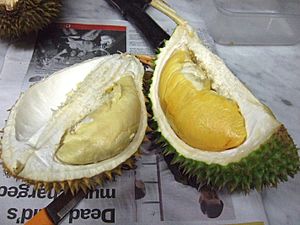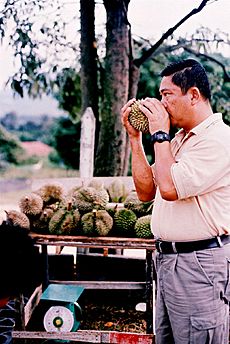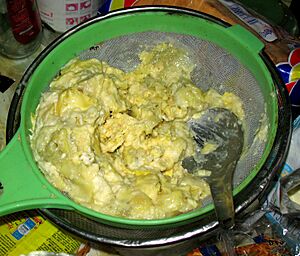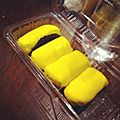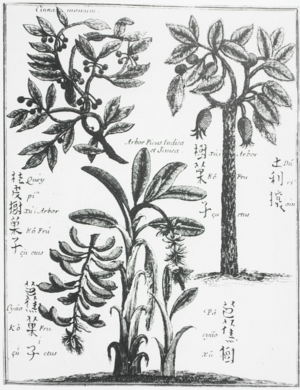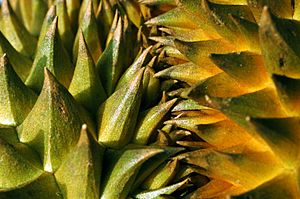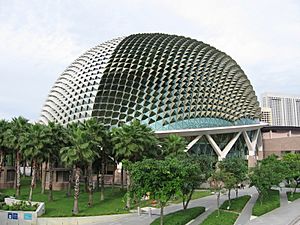Durian facts for kids
Quick facts for kids Durian |
|
|---|---|
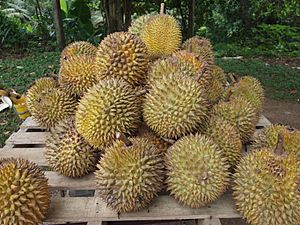 |
|
| Bunch of durian | |
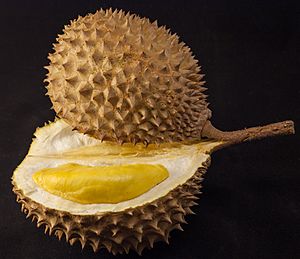 |
|
| Scientific classification |
|
| Kingdom: | Plantae |
| Clade: | Tracheophytes |
| Clade: | Angiosperms |
| Clade: | Eudicots |
| Clade: | Rosids |
| Order: | Malvales |
| Family: | Malvaceae |
| Subfamily: | Helicteroideae |
| Tribe: | Durioneae |
| Genus: | Durio L. |
| Type species | |
| Durio zibethinus L.
|
|
| Species | |
|
There are currently 30 recognised species (see the List of Durio species) |
|
| Synonyms | |
|
Lahia Hassk. |
|
The durian is a unique fruit that grows on trees. It's known for its large size, strong smell, and spiky skin. Some people call it the "king of fruits"! There are about 30 different kinds of durian trees. At least nine of these trees grow fruit that people can eat.
The most common type of durian you'll find in stores is called Durio zibethinus. This fruit originally comes from places like Borneo and Sumatra. A durian fruit can be as big as 30 centimeters (12 inches) long and 15 centimeters (6 inches) wide. It usually weighs between 1 to 3 kilograms (2 to 7 pounds). Its shape can be round or oval, and its skin can be green or brown. The inside flesh can be pale yellow to red, depending on the type.
The durian's smell is very famous! Some people love its sweet scent, while others find it very strong and unpleasant. People have described the smell as rotten onions, turpentine, or even sewage. Because the smell can last for days, some hotels and public transport in Southeast Asia don't allow durians. But the famous scientist Alfred Russel Wallace once said its flesh tasted like "a rich custard highly flavored with almonds." You can eat the fruit at different stages of ripeness. It's used in many sweet and savory dishes in Southeast Asian cooking. Even the seeds can be cooked and eaten!
Contents
What's in a Name?
The name "durian" first appeared around 1580. It comes from the Malay language word dûrî, which means 'thorn'. This makes sense because of the fruit's many sharp thorns. The scientific name for the most common durian, zibethinus, comes from the civet animal. Civets are known for their strong smell, just like the durian!
How Durian Trees Grow

Durian trees are very tall, growing up to 25 to 50 meters (82 to 164 feet) high. Their leaves stay green all year round. The flowers grow in clusters on big branches or directly on the tree trunk. Each flower has petals, usually five of them.
Durian trees usually have one or two times a year when they flower and produce fruit. A durian tree can start growing fruit after about four or five years. The fruit hangs from any branch and takes about three months to ripen after the flowers are pollinated.
There are 30 known types of Durio trees, and nine of them produce fruit that people can eat. The most common one grown for sale is Durio zibethinus. This type of durian has many different varieties, which means their fruits can vary in color, smell, and size.
Durian flowers are large and have lots of nectar. They give off a strong, sour, and buttery smell. These features help attract bats, which are important for pollinating the flowers. Some studies also show that birds and giant honey bees help pollinate certain durian species.
Different Types of Durian
Over many years, people in Southeast Asia have created many different types of durian, called "cultivars." These are grown from parts of trees that produce the best fruit. Each type can be a bit different in fruit shape or even the shape of its thorns. People often prefer certain types, and these can sell for higher prices.
Thai Durians
Many durian types have a common name and a code number, like "D24" or "D159." In Thailand, there are over 200 different types of D. zibethinus.
- Mon Thong (D159) is very popular for selling because it has thick, creamy, sweet flesh with a milder smell and smaller seeds.
- Chanee (D123) is good because it's strong against certain plant diseases.
- Kan Yao (D158) is special because it stays sweet and less smelly for a longer time.
Thai scientists have even created new types, like Chantaburi No. 1, which doesn't have the famous strong smell! Another type, Chantaburi No. 3, only develops its strong smell a few days after it's picked. This makes it easier to transport without the smell, but still lets people enjoy the strong scent later.
Malaysian Durians

In Malaysia and Singapore, popular types include "D24" and "XO." "D24" is known for its bittersweet taste. "XO" has pale, thick flesh with a slightly alcoholic taste.
Musang King is the most popular durian type from Malaysia. It's often the most expensive! The name "Musang King" comes from a story about a man who found a special durian tree in a place called Gua Musang ("Civet Cave"). Musang King is known for its bright yellow flesh and a very strong, rich flavor.
Malaysia has registered over 100 different types of durian since 1934. They look for types with good color, texture, smell, taste, and that produce a lot of fruit.
Indonesian Durians
Indonesia has more than 100 types of durian. The most common one grown there is also Durio zibethinus. Some well-known types include Sukun durian, Sitokong, Simas, and Petruk.
Where Durians Grow and Are Sold
Durians grow in warm, tropical places. They stop growing if the temperature drops below 22 degrees Celsius (72 degrees Fahrenheit). The island of Borneo is a very important place for durian diversity, where many different types grow wild.
Even though durian isn't originally from Thailand, Thailand is the world's biggest exporter of durian. They produce about 700,000 tons of durian each year! Much of this is sent to China and Hong Kong. Malaysia and Indonesia also produce a lot of durian.
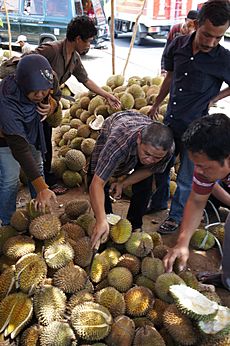

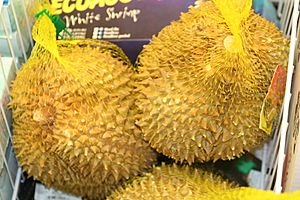
Durian is a seasonal fruit, meaning it's only available at certain times of the year. In Malaysia and Singapore, the durian season is usually from June to August.
Durians can be quite expensive, especially the popular types like Musang King. In Singapore, a kilogram of durian can cost between S$8 to S$15 (about US$5 to US$10). Since the edible part of the fruit is only about 15-30% of its total weight, a single durian can cost a fair bit!
The Famous Smell and Taste
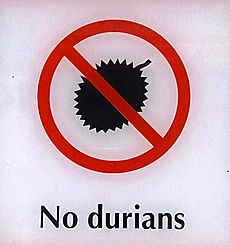
The durian's unique flavor and smell make people have very strong opinions about it. Some love it, some hate it!
The British scientist Alfred Russel Wallace described the durian's taste in 1856. He said it was like "a rich custard highly flavored with almonds." But he also mentioned hints of cream-cheese, onion-sauce, and sherry-wine! He found the texture to be smooth and delicious. Wallace said that once he tried a ripe durian, he became a "confirmed Durian eater." He even quoted a traveler from 1599 who said it "surpasses in flavor all other fruits of the world."
The smell of durian can be different depending on the type. For example, red durian has a deep caramel flavor with a turpentine smell. Red-fleshed durian smells like roasted almonds. Thai durians are often sweeter and less smelly than Malaysian ones. How ripe the fruit is also changes its flavor.
Scientists have found that certain chemicals, especially those with sulfur, are responsible for the durian's strong smell. These chemicals can be detected by animals from far away, which helps spread the seeds. Animals like squirrels, pigs, sun bears, and even elephants love to eat durians! The spiky skin helps protect the seeds from smaller animals, so larger animals are more likely to carry the seeds far away.
How to Pick a Ripe Durian
Some people say a durian is ready to eat when its skin starts to crack. However, what's considered "perfectly ripe" can be different in various places. In some parts of Thailand, people like their durians young and crisp. In other areas, they prefer the fruit soft and very fragrant. In Malaysia and Singapore, many people like their durians as ripe and smelly as possible! When it's very ripe, the flesh becomes creamy and has a complex flavor.
A durian that falls from the tree will continue to ripen for a few days. After about five or six days, most people would find it too ripe to eat fresh.
How Durian is Used
Cooking with Durian
Durian fruit is used in many sweet dishes. You can find it in traditional Malay candies, ice cream, milkshakes, mooncakes, and even coffee! Es durian (durian ice cream) is a popular dessert in Indonesia. Pulut Durian is glutinous rice served with ripe durian and coconut milk.
Tempoyak is a special dish made from fermented durian. It's usually made from durians that aren't good enough to eat fresh. Tempoyak can be eaten cooked or uncooked, often with rice, or used in curry. Sambal Tempoyak is a spicy Malay dish made with fermented durian and coconut milk.
In Thailand, durian is often eaten fresh with sweet sticky rice. Unripe durians can even be cooked like a vegetable! The seeds, which are about the size of chestnuts, can be boiled, roasted, or fried. They taste a bit like taro or yam. However, uncooked durian seeds can be toxic, so they should always be cooked first.
Sometimes, the young leaves and shoots of the durian tree are cooked as greens. The ash from burned durian skin is even added to special cakes!
-
Durian market in Thailand
-
Ketan durian, glutinous rice with durian sauce in Indonesia
-
Durian cake made of durian-flavoured dodol, Indonesian traditional sweet candy
-
A street side durian ice cream in Bogor, West Java, Indonesia
-
Durian pancake in Indonesia
-
Durian cakes from Pontianak, West Kalimantan, Indonesia
Durian Nutrition
| Nutritional value per 100 g (3.5 oz) | |
|---|---|
| Energy | 615 kJ (147 kcal) |
|
27.09 g
|
|
| Dietary fibre | 3.8 g |
|
5.33 g
|
|
|
Protein
|
1.47 g
|
| Vitamins | Quantity
%DV†
|
| Vitamin A | 44 IU |
| Thiamine (B1) |
33%
0.374 mg |
| Riboflavin (B2) |
17%
0.2 mg |
| Niacin (B3) |
7%
1.074 mg |
| Pantothenic acid (B5) |
5%
0.23 mg |
| Vitamin B6 |
24%
0.316 mg |
| Folate (B9) |
9%
36 μg |
| Vitamin C |
24%
19.7 mg |
| Minerals | Quantity
%DV†
|
| Calcium |
1%
6 mg |
| Copper |
10%
0.207 mg |
| Iron |
3%
0.43 mg |
| Magnesium |
8%
30 mg |
| Manganese |
15%
0.325 mg |
| Phosphorus |
6%
39 mg |
| Potassium |
15%
436 mg |
| Sodium |
0%
2 mg |
| Zinc |
3%
0.28 mg |
| Other constituents | Quantity |
| Water | 65 g |
|
from the USDA National Nutrient Database
|
|
| †Percentages estimated using US recommendations for adults. | |
Raw durian is mostly water (65%). It also has a good amount of carbohydrates (27%), some fat (5%), and a little protein (1%). A 100-gram serving of durian gives you a lot of thiamine (a B vitamin) and some vitamin C and other important minerals.
Durian Through History
Durians are believed to have first grown in Borneo and Sumatra. Wild durian trees can be found in the Malay Peninsula, and people have grown them in gardens from India to New Guinea for a long time. Four hundred years ago, durian was traded in places like Myanmar, Thailand, and South Vietnam.
The first time Europeans wrote about durian was in the 15th century by a traveler named Niccolò de' Conti. He described it as a green fruit, as big as a watermelon, with five parts inside that tasted like thick butter.
In the 18th century, a botanist named Georg Eberhard Rumphius wrote a very detailed description of durians. For a while, people sometimes confused durian with another spiky green fruit called soursop.
Durian trees were brought to Sri Lanka by the Portuguese in the 16th century. They have also been planted in botanical gardens in the Americas. People in Southeast Asia have been growing durians for centuries, first in villages and then for commercial sale. Since the 1990s, more and more people around the world want to buy durians.
Durian in Culture and Beliefs
People in Southeast Asia often believe that eating durian with coffee or alcohol is bad for you. This idea goes back to the 18th century. Some studies suggest that durian's high sulfur content might affect how your body breaks down certain things.
The durian is often called the "king of fruits" because of its impressive look and strong smell. In its home region, durian is a common food and appears in local media. For example, a building in Singapore, the Esplanade – Theatres on the Bay, is often called "The Durian" because of its spiky shape. The city of Jakarta, Indonesia, is sometimes nicknamed "The Big Durian."
A durian falling on someone's head can be dangerous because the fruit is heavy and has sharp thorns. Wearing a hardhat is a good idea when collecting the fruit. There's a saying that a durian has "eyes" and won't fall during the day when people are around, but sadly, people have been hurt by falling durians. Farmers often put nets under durian trees to catch the fruit, keep animals away, and protect people.
There are even types of durian that don't have spines! One was found in the Philippines in the 1960s. In Malaysia, there's a registered spineless durian type called "Durian Botak," which means 'Bald Durian'.
Animals like Sumatran elephants and tigers are known to eat durians.
Traditional Uses
In Malaysia, people used to make a special drink from durian leaves and roots to help with fevers. The juice from the leaves was also put on the head of someone with a fever.
Traditional beliefs in Southeast Asia and Chinese food therapy say that durian has "warming" properties, which means it might make you sweat a lot. To balance this, people traditionally pour water into the empty durian shell after eating the fruit and drink it. Another way is to eat durian with mangosteen, which is thought to have "cooling" properties. Pregnant women or people with high blood pressure are often advised not to eat durian.
Environmental Concerns
Because more and more people in China want durians, there's a growing demand for them. This has led to some forests in Malaysia being cleared to make space for large durian farms.
Images for kids
-
Musang King, the most popular variety of durian in Malaysia
See also
 In Spanish: Durian para niños
In Spanish: Durian para niños


